Themed collection Circularly Polarised Luminescence

Circularly polarized luminescence: a themed collection
Guest editors Jeanne Crassous, Lorenzo Di Bari, Wai-Yeung Wong and You-Xuan Zheng introduce this themed collection on circularly polarized luminescence.

J. Mater. Chem. C, 2023,11, 5905-5907
https://doi.org/10.1039/D3TC90079G
Metal halide perovskites: promising materials toward next-generation circularly polarized luminescence
Metal halide perovskites (MHPs) have emerged as highly appealing materials for circularly polarized luminescence (CPL) related applications, owing to their spin-related photoelectric properties and flexible structural adjustment.

J. Mater. Chem. C, 2023,11, 4993-5008
https://doi.org/10.1039/D2TC04825F
Compact CPL emitters based on a [2.2]paracyclophane scaffold: recent developments and future perspectives
This perspective discusses the synthesis and (chir)optical properties of compact luminophores derived from [2.2]paracyclophane useful as building blocks for the development of CPL emitters.
![Graphical abstract: Compact CPL emitters based on a [2.2]paracyclophane scaffold: recent developments and future perspectives](/en/Image/Get?imageInfo.ImageType=GA&imageInfo.ImageIdentifier.ManuscriptID=D2TC04885J&imageInfo.ImageIdentifier.Year=2023)
J. Mater. Chem. C, 2023,11, 2053-2062
https://doi.org/10.1039/D2TC04885J
From 0 to N: circularly polarized luminescence generation from achiral luminophores in fibrous morphologies
Fibrous morphologies are ideal carriers for achiral fluorescent molecules to achieve CPL. Examples and underlying mechanisms of chirality transfer, amplification, and reversion at the single- and multiple-fiber levels are presented in this review.

J. Mater. Chem. C, 2023,11, 7526-7537
https://doi.org/10.1039/D3TC01404E
Advances in circularly polarized luminescence materials based on helical polymers
The recent advances and future perspectives on circularly polarized luminescence materials based on optically active helical polymers are reviewed and discussed.

J. Mater. Chem. C, 2023,11, 1242-1250
https://doi.org/10.1039/D2TC04715B
A switchable system between magnetic and natural circularly polarised luminescence via J-aggregation using photosynthetic antenna model compounds
Using zinc-chlorin, the switching of MCPL/CPL via J-aggregation has been clearly demonstrated for the first time.
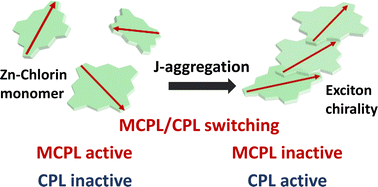
J. Mater. Chem. C, 2023,11, 2831-2835
https://doi.org/10.1039/D2TC04841H
Circularly polarized luminescent organogels based on fluorescence resonance energy transfer in an achiral polymer system
Circularly polarized luminescent chiral organogels based on fluorescence resonance energy transfer are fabricated by supramolecular co-assembly in an achiral polymer system, in which a wavelength shift and amplified glum are achieved.

J. Mater. Chem. C, 2023,11, 2475-2479
https://doi.org/10.1039/D2TC05101J
Bacterial cellulose wave plates for polarization-encryption applications
Bacterial cellulose (BC)-based wave plates with tunable phase delays for polarization-encryption applications.
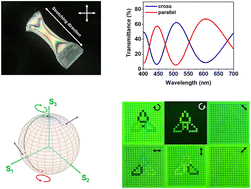
J. Mater. Chem. C, 2023,11, 1684-1689
https://doi.org/10.1039/D2TC05142G
A circularly polarized (CP) white organic light-emitting diode (WOLED) based on a chiral organo-Sm3+ complex
Using the chiral [Sm(tta)3(D-phen)] as emitter, the first example of chiral organo-Ln3+-based CP-WOLED with both attractive white-light efficiencies (ηMaxEQE = 1.55% and ηMaxCE = 1.61 cd A−1) and high dissymmetry factor (|gEL|Max = 0.011) is reported.

J. Mater. Chem. C, 2023,11, 1265-1270
https://doi.org/10.1039/D2TC04802G
Amplification of dissymmetry factors by dihedral angle engineering in donor–acceptor type circularly polarized luminescence materials
A new donor–acceptor type circularly polarized luminescence material has been developed, and a dihedral angle engineering strategy has been demonstrated for the first time to significantly amplify the luminescence dissymmetry factors.
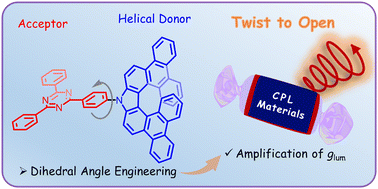
J. Mater. Chem. C, 2023,11, 893-897
https://doi.org/10.1039/D2TC04848E
Tuning CPL by helical pitch modulation in helically flexible small organic multichromophores
Modulating the helical pitch by simply playing with steric effects in a series of helically flexible BODIPY dimers allows easy tuning of the luminescence dissymmetry factors associated with their circularly polarized emissions.
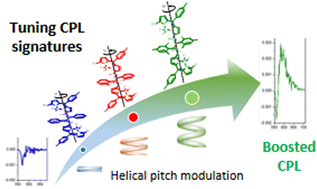
J. Mater. Chem. C, 2023,11, 456-461
https://doi.org/10.1039/D2TC04793D
Effect of quantum confinement on polarization anisotropy emission in Sn-doped CdS microcones
We prove the relationship between the cross-section radius and polarization ratio, and demonstrate the maximum polarization ratio is about 60% when the cross-section radius is 1.15 μm in a Sn-doped CdS microcone.

Mater. Adv., 2022,3, 8407-8412
https://doi.org/10.1039/D2MA00883A
CPL calculations of [7]helicenes with alleged exceptional emission dissymmetry values
Probing the Chiroptical Enigma: compelling evidence calling for a re-evaluation of experimental glum values of two 1,1′-bitriphenylene-based [7]helicenes is obtained by TD-DFT simulations with advanced state-specific solvation effects.
![Graphical abstract: CPL calculations of [7]helicenes with alleged exceptional emission dissymmetry values](/en/Image/Get?imageInfo.ImageType=GA&imageInfo.ImageIdentifier.ManuscriptID=D3TC01532G&imageInfo.ImageIdentifier.Year=2023)
J. Mater. Chem. C, 2023,11, 10474-10482
https://doi.org/10.1039/D3TC01532G
Atomistic modeling of metal–ligand chirality transfer and chiroptical properties of lead and tin hybrid perovskites
Models of chiral hybrid perovskites are studied by ab initio molecular dynamics, projected density of states, TD-DFT and ECD spectra calculations to clarify how the chiral bias affects the inorganic octahedra and how it differs in lead and tin cases.

J. Mater. Chem. C, 2023,11, 9135-9143
https://doi.org/10.1039/D3TC00507K
Circularly polarized luminescence in the one-dimensional assembly of binaphtyl-based Yb(III) single-molecule magnets
Field-induced single-molecule magnet behavior and circularly polarized luminescence were observed in a series of ytterbium one-dimensional coordination polymers involving chiral BINOL-derived bisphosphate ligands.

J. Mater. Chem. C, 2023,11, 7299-7310
https://doi.org/10.1039/D3TC00858D
Chiral diketopyrrolopyrrole dyes showing light emission in solid and aggregate states
Chiral tetraarylethylene-diketopyrrolopyrroles, synthesized by a strategy involving a Mitsunobu type N-alkylation and Suzuki–Miyaura coupling, show CD and circularly polarized luminescence in solution and enhanced emission in the aggregate states.

J. Mater. Chem. C, 2023,11, 5701-5713
https://doi.org/10.1039/D3TC00308F
Dynamic CPL switching realized in chiral Mn-based metal halides with reversible thermochromism
(R-/S-Br-MBA)3MnBr5 shows reversible conversion of CPL emission in wavelength and direction during heating and cooling.

J. Mater. Chem. C, 2023,11, 5461-5468
https://doi.org/10.1039/D2TC05349G
Intense 1400–1600 nm circularly polarised luminescence from homo- and heteroleptic chiral erbium complexes
Efficient near-infrared circularly polarised luminescence (CPL) between 1400 and 1600 nm of four enantiomer pairs of homo- and heteroleptic complexes have been successfully measured.
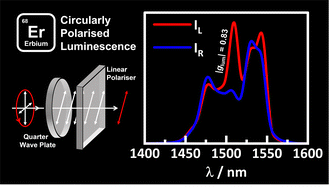
J. Mater. Chem. C, 2023,11, 5290-5296
https://doi.org/10.1039/D3TC00034F
Circularly polarized activity from two photon excitable europium and samarium chiral bioprobes
Circularly polarized luminescence activity from new cationic water soluble Sm(III) and Eu(III) complexes is triggered by one- and two-photon absorption processes. The Eu(III) complex is shown to be an efficient NIR-to-RED probe in cellulo.

J. Mater. Chem. C, 2023,11, 4188-4202
https://doi.org/10.1039/D2TC05362D
Design of high-performance circularly polarized multiple resonance-based TADF materials via participatory chiral perturbation
The materials incorporating a moderate electron-donating chiral unit (BAM) closer to the chromophore and participating in the frontier molecular orbitals distributions may achieve a balance between a large g value and high fluorescence quantum yield.
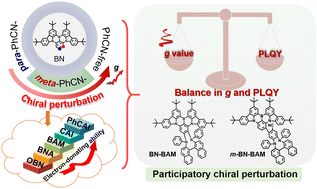
J. Mater. Chem. C, 2023,11, 4033-4041
https://doi.org/10.1039/D2TC05229F
Circularly polarized organic room temperature phosphorescence activated by liquid crystalline polymer networks
Circularly polarized organic room temperature phosphorescence (CPRTP) with gmax = +0.098 was activated by the rigid environment of an in situ cross-linked liquid crystalline polymer network.

J. Mater. Chem. C, 2023,11, 4104-4111
https://doi.org/10.1039/D2TC04829A
Chiral hybrid manganese(II) halide clusters with circularly polarized luminescence for X-ray imaging
Two pairs of enantiomorphic organic–inorganic hybrid manganese(II) halide clusters show excellent CPL properties and work as scintillators in X-ray detection and imaging.
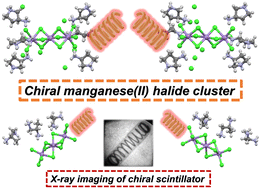
J. Mater. Chem. C, 2023,11, 3206-3212
https://doi.org/10.1039/D2TC05379A
Effects of molecular ordering on circularly polarized emission from a twisted mesogenic conjugated polymer
The measured EL g factors (symbols) were fitted with a quadratic equation of the order parameter in the twisted configuration of a mesogenic conjugate polymer (F8BT) doped with various concentrations of a chiral dopant (R5011).

J. Mater. Chem. C, 2023,11, 3300-3305
https://doi.org/10.1039/D2TC04814K
IrAu12 superatom modified by chiral diphosphines: doping-induced enhancement of chiroptical activity
Chiroptical activities of Au13 superatom modified with chiral ligands were enhanced by doping of an Ir atom at the center of the core. The IrAu12 superatom exhibited the brighter circularly polarized luminescence than Au13 superatom.
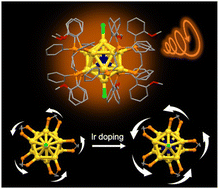
J. Mater. Chem. C, 2023,11, 3095-3100
https://doi.org/10.1039/D2TC05321G
Controlled molecular assemblies of chiral boron dipyrromethene derivatives for circularly polarized luminescence in the red and near-infrared regions
We demonstrated the aggregation-enhanced emission and circularly polarized luminescence of chiral 1,1′-bi-2-naphthol-substituted boron dipyrromethene derivatives in the red and near-infrared regions.
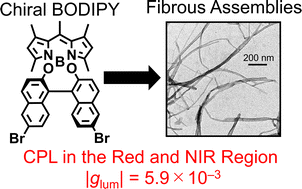
J. Mater. Chem. C, 2023,11, 2889-2896
https://doi.org/10.1039/D2TC05006D
EuIII functionalized silica nanoparticles encapsulating chiral CrIII complexes with simultaneous unpolarized red and polarized NIR-I luminescence
Mixing a chiral Cr(III) complex with an achiral Eu(III) complex into a silica nanoparticle gave rise to simultaneous unpolarized red and polarized NIR luminescence.
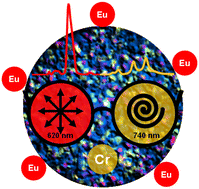
J. Mater. Chem. C, 2023,11, 2582-2590
https://doi.org/10.1039/D2TC05344F
2D self-assembly of o-OPE foldamers for chiroptical barcoding
2D films of enantiopure stapled o-OPEs have been used to develop a CPL-barcoding system free of photoselection artifacts. The use of both enantiomers makes the system easier and safer to read.

J. Mater. Chem. C, 2023,11, 2591-2599
https://doi.org/10.1039/D2TC05208C
Color-tuning and boosting circularly polarized luminescence performance of axially chiral tetra-BF2 complexes by post-modifications
Multicolored fluorescence, high ΦPL reaching 59%, and an efficient glum up to 0.01 with the brightness for circularly polarized luminescence (125.2 M−1 cm−1), were achieved in axially chiral tetra-BF2 complexes by substituent engineering.

J. Mater. Chem. C, 2023,11, 2574-2581
https://doi.org/10.1039/D2TC04636A
Circularly polarised photoluminescence and electroluminescence of chiral copper(I) dimers based on R/S-2,2′-bis(diphenylphosphino)-1,1′-binaphthalene ligands
R/S-(BINAP)2Cu(μ-I2) enantiomer doped films show a high |gPL| factor above 1 × 10−2, while a pioneering work of CP-OLEDs based on chiral Cu(I) enantiomers exhibited a high EQE of 21.7% and |gEL| factors of around 3.0 × 10−3.

J. Mater. Chem. C, 2023,11, 1329-1335
https://doi.org/10.1039/D2TC04895G
Thermally stable and rewritable circularly polarized luminescent helical poly(diphenylacetylene)s: stabilization of macromolecular helicity memory via reversible ion-pair formation
An enhancement of stability of helicity memory, solubility, and fluorescence properties of a poly(diphenylacetylene) has been achieved through ion-pair formation.
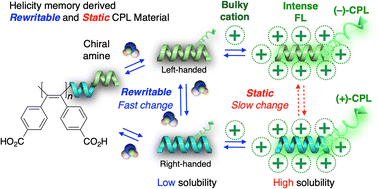
J. Mater. Chem. C, 2023,11, 1271-1277
https://doi.org/10.1039/D2TC04847G
Optical resolution of pseudo-para-disubstituted [2.2]paracyclophane: a chiral building block for optically active helicene-stacked molecules emitting circularly polarized luminescence
Optical resolution of pseudo-para-disubstituted [2.2]paracyclophane was achieved by the diastereomer method. Enantiopure optically active molecules emitting circularly polarized luminescence were synthesized.
![Graphical abstract: Optical resolution of pseudo-para-disubstituted [2.2]paracyclophane: a chiral building block for optically active helicene-stacked molecules emitting circularly polarized luminescence](/en/Image/Get?imageInfo.ImageType=GA&imageInfo.ImageIdentifier.ManuscriptID=D2TC04652K&imageInfo.ImageIdentifier.Year=2023)
J. Mater. Chem. C, 2023,11, 986-993
https://doi.org/10.1039/D2TC04652K
Particle dispersion system consisting of helically assembled liquid crystalline poly(para-phenylene)derivatives with reproducible chiroptical properties
A liquid crystalline poly(para-phenylene) derivative forms a helically π-stacked structure upon addition of a chiral binaphthyl compound, exhibiting blue circularly polarized luminescence.

J. Mater. Chem. C, 2023,11, 943-952
https://doi.org/10.1039/D2TC03747E
Organic microspheres and microcrystals made from pyridine-functionalized chromophores and a chiral phosphoric acid
CPL-active microspheres and microcrystals are fabricated via the reaction and co-assembly of pyridine derivatives with a chiral phosphoric acid.
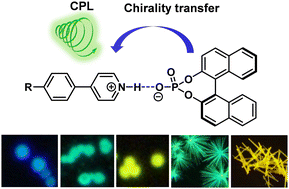
J. Mater. Chem. C, 2023,11, 676-684
https://doi.org/10.1039/D2TC04818C
Thermally stable and strongly emitted CPL in Eu(D-facam)3 hybrid solids with an alkylammonium salt
A novel europium-based hybrid material, Eu(D-facam)3-TMAOAc (tetramethylammonium acetate), with ultra-high luminescence, excellent circular polarization and remarkable thermostability was prepared.
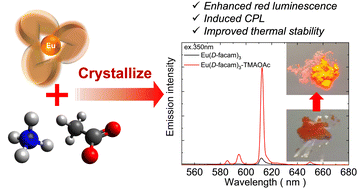
J. Mater. Chem. C, 2023,11, 118-126
https://doi.org/10.1039/D2TC04670A
Stimuli-responsive helical polymeric particles with amplified circularly polarized luminescence
We fabricated stimuli-responsive solid particles with amplified circularly polarized luminescence based on a cis-transoidal helix, temperature-responsive and pH-responsive CPL properties.

J. Mater. Chem. C, 2023,11, 172-182
https://doi.org/10.1039/D2TC04292D
Chiral coordination compounds with exceptional enantioselectivity
The new homochiral Zn-based coordination compounds reveal excellent enantioselective sensing behavior toward D- and L-histidine attributed to the host–guest interactions through the rigid chiral backbones.

J. Mater. Chem. C, 2022,10, 17127-17134
https://doi.org/10.1039/D2TC04016F
Impact of crystal growth diversity on magneto-photoluminescence and circular dichroism in chiral lead halide perovskites
By tuning weight percentages rationally for precursor solutions, we found that large magneto-PL (−13.2%) with strong tunability via polarized photoexcitation is highly decided by crystallographic orientations for chiral perovskites.

J. Mater. Chem. C, 2022,10, 16706-16713
https://doi.org/10.1039/D2TC03810B
About this collection
We are delighted to introduce a new themed collection on ‘Circularly Polarised Luminescence’ in Journal of Materials Chemistry C, guest edited by Jeanne Crassous (University of Rennes 1), Lorenzo Di Bari (University of Pisa), Wai-Yeung Wong (The Hong Kong Polytechnic University), and You-Xuan Zheng (Nanjing University).
Chirality is a basic property of Nature and plays an important role in the Universe (homochirality of living systems). Chiral materials are also widely used in many areas, such as medicines and chemical reagents, catalysts, and emitters. Interestingly, chiral emitters can display circularly polarized luminescence (CPL) which is the difference of left- and right-circularly polarized light components from chiral compounds and has recently revealed many fundamental interests and potential applications. The increasing recent interest of CPL technique is attributed to instrumental development, enabling development of strongly CPL-active chiral materials or systems, and to its application in many research areas such as in bio-responsive systems and for the development of smart materials for advanced photonic and electronic technologies (quantum computing, optical data storage and 3D displays, etc).
The aim of this themed collection is to bring together cutting-edge original articles regarding the synthesis, preparation and characterization, the theoretical simulations, the circular dichroism (CD) and CPL measurements of chiral molecules or systems including organic, inorganic materials and supramolecular aggregates with fluorescence, thermally activated delayed fluorescence, phosphorescence and long after-glow properties. Furthermore, the application of these materials in organic light-emitting diode (OLED), etc., are particularly welcome. The themed collection will provide a guidance for the future rational design of chiral molecules or systems suitable for various CPL properties and applications.